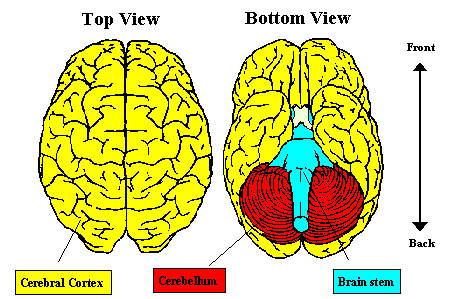
(Image from Neuroscience for kids -- The Powers That Be)
| MadSci Network: Neuroscience |
From a practical standpoint . . . nothing; however, we need to define some terms:
Coma: absence of a conscious response to internal and environmental stimuli.
Thus, a coma means unconciousness. During a dreamless part of sleep--which may, actually, be dreams you do not remember later--you are "unconscious." Now, I add the "" because coma requires an inability to respond to the stimuli. In the case of your dreamless sleep, a stimuli--the cat jumping on you--will wake you. Also, sleepers demonstrate responses to stimuli. Unlike a true coma, sleep is a very active event for the brain.
Now, to understand a coma one has to get rid of "Hollywood" and even popular medical conceptions--"Man awakes from coma after 32.37 years, asks for bagel!" headlines.
In the case of coma, the person cannot respond to stimuli. He is unconscious. It is not the case as seen in the movies where he is "really" in some fantasy land and--if only--we could reach him. . . . Anyone who has been knocked unconscious understands the concept. You are not "there" at all.
People do not remain in a coma. Even the most severly damaged will "progress" into a persistent vegetative state. In this case, the person will demonstrate sleep-wake cycles--eyes will open spontaneously. The person may demonstrate some really complex reflexes--staring, or looking at a noise, grasping, grimace, et cetera. Where the "woke up from a coma" stories come from is from patients who were not really in a coma. Since the person in a persistent vegetative state does respond to a stimuli--sleep-wake, a noise, et cetera, the person is not "really" in a coma even though he demonstrates no conscious perception. That would conflict with my above definition; however, I retain it to rule out a "reflexive" response. Is the person in the persistent vegetative state responding at all consciously? Usually no, so the definitions can seem a bit capricious. Thus, by convention, the eye-opening serves as a division of sorts.
Great . . . what does that mean for the patient? Not a lot. Those that "wake-up" often have demonstrated a conscious response for quite some time--it may not appear that great to an observer. Also, their "waking up" may not seem that impressive either. Finally, add confounding effects that can decrease consciousness and this clouds the picture further.
Which brings me to the mechanism. Those only interested in the primary question can stop here. What follows is how we are conscious.
Consciousness 101
For the sake of example, picture the brain. I would post a picture, but I am concerned with "stealing" an image from another site. Perhaps one of the Powers that Be will provide one. Anyways, we can artificially divide the brain into its brain stem and the cerebrum.

(Image from Neuroscience for
kids -- The Powers That Be)
There are really only two ways to lose consciousness:
1. Effect a global assault on both cerebral cortices.
2. Separate the cortices from the brain stem ascending reticular activating system.
The first is easier to explain. A good example is drugs. Drugs that depress your cerebral hemispheres will, eventually, render you unconscious. If they work as well on your brain stem they will render you dead, of course. The thing to understand is those with damage on one side of their brain--classic "stroke"--do not lose consciousness.
The second is more technical. The Ascending Reticular Activating System (ARAS) [Cue Thunderclap.--Ed.] is a part of the brain stem. The reticular formation is a diffuse region of cells that look like a lattice-work. These areas send and receive information from all areas of the brain and spinal cord. One area near the top of the brain stem--the midbrain or mesencephalon for the sequipedalians--triggers the cerebral cortices to be conscious.
Damage or inpairment to this area lowers and eventually abolishes consciousness. A patient with damage below the region will retain consciousness but may be unable to move his limbs, speak, or do anything else other than blink. This tragedy represents the Locked-In Syndrome.
Thus, the patient in a coma has either diffusely depressed or destroyed cortices, or some inability of his ARAS to maintain consciousness.
Which brings us to the topic of Brain Death. The definition--legal--of Brain Death depends on where you live--what country. In the United States, death of the entire brain represents death. Fine. Can someone live on just a brain stem. Yes, unfortunately. Such people will, eventually, reach a persistent vegetative state except in rare circumstances. The brain stem works, which we can confirm by tests: pupils react, eyes move together, blinking to stimulus to the cornea, all the way to gaging and coughing.
From a philosophical standpoint, the person as a "person" is dead.
References:
The classic text--a true classic--remains Plum and Posner's Diagnosis of Stupor and Coma. It is the written by two venerable leaders in the field. It should really come into a new edition to reflect the advent of CAT and MRI scans.
Doctor X
Try the links in the MadSci Library for more information on Neuroscience.